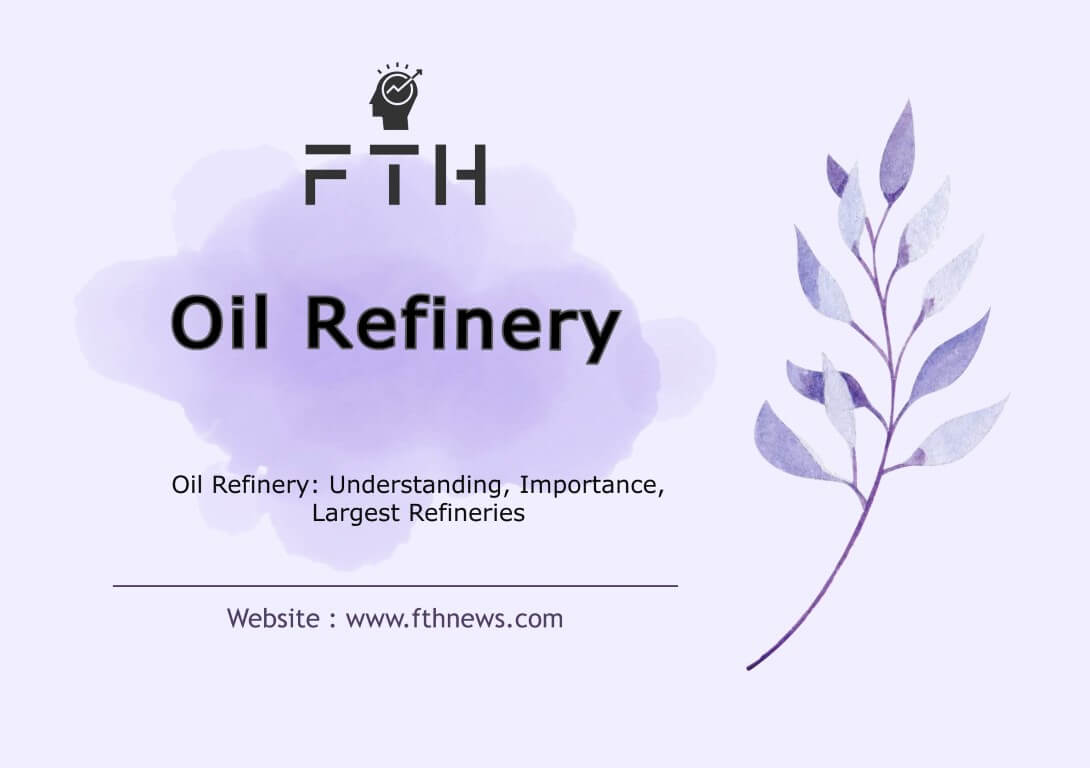
Oil Refinery: Understanding, Importance, Largest Refineries
Oil Refinery serve as the backbone of the global energy market, transforming crude oil into various valuable products that propel economies and provide energy security. This article delves into the intricacies of oil refineries, their crucial role in global energy, and explores the eight largest refineries worldwide, shedding light on their capacities and the countries hosting them.
What is an Oil Refinery ?
Oil refineries, the colossal engines driving the production of petroleum products, assume a critical role in the conversion of crude oil into indispensable fuels like gasoline, diesel, kerosene, and an array of other products. The intricate refining process unfolds in three integral stages: separation, conversion, and purification.
Separation Phase:
In this initial phase, crude oil embarks on a journey of distillation, undergoing a meticulous separation process based on boiling points. As the raw material traverses hot furnaces, the resultant liquids and vapors are directed into distillation units, where they undergo fractional separation. The lighter fractions, such as gasoline, ascend to the pinnacle of the distillation tower, while the heavier counterparts settle in the lower echelons. This orchestrated separation is fundamental to the subsequent stages of the refining process.
Conversion Phase:
Following the separation stage, the journey of heavier fractions commences in the conversion phase. Within specialized units encompassing robust reactors, furnaces, and heat exchangers, these heavier fractions are metamorphosed into higher-value products, with a spotlight on the production of gasoline. The intricate alchemy occurring within these units is instrumental in enhancing the economic value of the refined products.
Purification Phase:
The culmination of the refining process unfolds in the purification phase, where stringent measures are undertaken to eliminate unwanted contaminants. This final stage serves a dual purpose: ensuring the stability of the refined products and mitigating the environmental impact. By ridding the products of impurities, oil refineries not only meet quality standards but also contribute to environmental sustainability.
Importance of Oil Refinery for Countries
Countries that possess the capability to refine their own petroleum products enjoy a spectrum of strategic advantages, fostering stability and prosperity on multiple fronts.
Energy Security:
The intrinsic value of self-produced oil lies in its capacity to diminish a nation’s reliance on external energy sources. By cultivating a self-sufficient energy ecosystem through oil refineries, countries bolster their energy security, mitigating the vulnerability associated with dependence on foreign supplies. This autonomy in energy production establishes a robust foundation for a stable and resilient energy supply chain.
Economic Growth:
Beyond the immediate benefits of energy security, the presence of a thriving oil refining industry becomes a magnet for foreign investment. The allure of a nation’s self-sufficiency in oil production attracts capital, technology, and expertise, injecting vitality into the economy. This influx of investment creates a ripple effect, fostering job creation, skill development, and income generation. The oil industry thus becomes a catalyst for overall economic development, providing a cornerstone for sustained growth.
Foreign Exchange Earnings:
Oil, as a globally traded commodity, transforms into a significant source of foreign income for countries with robust refining capabilities. The export of refined petroleum products becomes a lucrative venture, contributing substantially to a nation’s foreign exchange reserves. This influx of foreign currency enhances a country’s financial standing on the global stage, empowering it to engage in international trade, investment, and economic partnerships with greater confidence and leverage.
In essence, oil refineries emerge as not only engines of energy independence but also as powerful catalysts for economic prosperity, job creation, and enhanced global financial standing for the nations that wield their refining capabilities effectively.
Challenges Limiting Oil Refinery Growth
While oil refineries offer substantial advantages, their growth is impeded by a multitude of challenges that necessitate careful consideration and strategic solutions.
Environmental Impact:
One of the primary hindrances to refinery expansion is the environmental impact associated with their operations. Refineries release harmful gases, contributing to air pollution and climate change. In a world increasingly focused on sustainability, these environmental concerns become substantial barriers, limiting the incentives for expansion. Striking a balance between industrial development and ecological preservation is crucial to address this challenge.
Limited Resource:
The finite nature of oil as a resource raises legitimate concerns about depletion. With estimates suggesting that a significant portion of the world’s oil reserves has already been utilized, the industry faces a fundamental challenge of sourcing new reserves. This limitation on the availability of raw materials directly impacts the potential growth of refineries, urging the exploration of alternative and sustainable energy sources.
Acid Rain Formation:
The burning of oil, a key component in the refining process, contributes to the formation of acid rain. This environmental consequence poses not only ecological threats to bodies of water but also triggers the need for stringent regulations. The imposition of such regulations acts as a deterrent for prospective investors, complicating the expansion of refineries. Developing technologies to minimize environmental impact becomes imperative in addressing this challenge.
Unsafe Oil Transportation:
The transportation of oil from refineries involves inherent risks, with frequent spills and accidents casting a shadow over the industry. More than an environmental concern, these incidents raise safety issues and discourage potential investors. Enhancing the safety protocols in oil transportation and exploring more secure methods are vital steps to mitigate this challenge.
Political Influence:
The geopolitical importance of oil often leads to conflicts and power struggles, making refinery investments a potential security risk. Political instability in regions rich in oil resources can disrupt operations and deter investors. A nuanced approach that considers geopolitical dynamics and fosters international cooperation is essential for overcoming this challenge.
Shift to Renewable Energy:
The global shift towards renewable energy sources presents a paradigm shift that directly impacts the demand for traditional petroleum products. As the world embraces cleaner alternatives, the appeal of new refineries diminishes. Adaptability becomes the key for the industry, necessitating investments in innovative technologies and a strategic transition towards sustainable practices to stay relevant in an evolving energy landscape.
In addressing these challenges, the oil refinery sector must embark on a transformative journey, embracing sustainability, innovation, and adaptability to secure its role in the future of global energy.
Role of Oil Refineries in Financial Markets
Recognizing the intricate nature of refinery investments, investors strategically navigate the financial landscape by engaging with refined product futures in prominent markets. These financial instruments, such as NYMEX RBOB Gasoline futures and NY Port ULSD futures contracts, provide a vital avenue for managing risks and capitalizing on profit opportunities.
Refined Product Trade:
In the volatile world of commodities, investors leverage refined product futures contracts as a shield against price fluctuations and a means to navigate the inherent risks associated with commodity price differences. These contracts empower investors to secure a predetermined price for refined products, insulating them from the unpredictability of market dynamics. This strategic approach ensures a level of stability in the face of price volatility, fostering confidence and informed decision-making.
Importance for Companies:
Companies operating in sectors with exposure to commodity prices find refuge in futures contracts as indispensable tools for risk management. Whether they are key players in the oil industry or downstream consumers heavily reliant on refined products, these companies utilize futures contracts to mitigate financial uncertainties stemming from unpredictable market conditions. By locking in prices through these contracts, companies gain a strategic advantage in planning budgets, projecting revenues, and safeguarding their bottom line against the fluctuations inherent in commodity markets.
As a result, the role of oil refineries extends beyond the confines of production and reaches into the dynamic world of financial markets. The strategic use of refined product futures not only fortifies investors against market volatilities but also empowers companies to navigate the complex terrain of commodity pricing with resilience and foresight. This symbiotic relationship between oil refineries and financial markets underscores the interconnectivity of economic sectors and the strategic foresight required to thrive in a rapidly evolving financial landscape.
The World’s Largest Oil Reserves and Refineries
The World’s Largest Oil Reserves:
At the forefront of the global oil reserves race, Venezuela emerges as the titan with proven reserves exceeding 300 billion barrels. This South American nation, rich in oil wealth, holds a pivotal position in shaping the dynamics of the global energy market. Following closely behind is Saudi Arabia, a key player with vast oil resources that contribute significantly to its economic influence and geopolitical standing.
The significance of these reserves extends beyond national boundaries, as countries with substantial oil wealth wield considerable influence in the global energy arena, shaping economic and political dynamics on an international scale.
The World’s 8 Largest Oil Refineries:
Embarking on a journey through the colossal infrastructure of oil refinement, we unravel insights into the eight largest oil refineries, each a testament to technological prowess and strategic significance.
Jamnagar Refinery, India:
Situated in India, the Jamnagar Refinery stands as a testament to engineering marvel. Commissioned in July 1999, this privately owned refinery boasts an unparalleled capacity of approximately 1,240,000 barrels per day. Its rapid construction revolutionized refinery architecture, transforming India from a net buyer to a net exporter of petroleum products, thus bolstering the country’s energy security.
Paraguaná Refinery Complex, Venezuela:
Located in northwestern Venezuela, the Paraguaná Refinery Complex is a formidable trio comprising the Carbon and Amuay refineries on the Paraguana peninsula and the Bajo Grande refinery in Zulia state. With a collective processing capacity of around 971,000 barrels per day, this complex, operated by Petróleos de Venezuela (PDVSA), stands as a cornerstone of Venezuela’s oil industry.
SK Energy Ulsan Refinery Complex, South Korea:
Pioneering the oil refining landscape in Asia, the SK Energy Ulsan Refinery Complex in South Korea holds a capacity of approximately 840,000 barrels per day. Established in 1964, it remains the largest refinery not only in South Korea but also in the entire Asian continent.
Ruwais Refinery, United Arab Emirates:
Nestled on the Arabian Gulf coast, the Ruwais Refinery in the United Arab Emirates is operated by the Abu Dhabi National Oil Company (ADNOC). Operational since 1982, it boasts a capacity of around 837,000 barrels per day, making it the largest refinery in the Middle East.
Yeosu Refinery, South Korea:
Operated by GS Caltex, the Yeosu Refinery in South Korea, established in 1969, processes approximately 800,000 barrels of crude oil daily. A joint venture between Chevron and GS Energy, it stands as Asia’s third-largest refinery.
Onsan Refinery, South Korea:
Situated in Ulsan, South Korea, the Onsan Refinery is an integrated facility opened in 1980, with an operational capacity of approximately 669,000 barrels per day. Operated by S-Oil Corporation Inc. and owned by Saudi Arabian Oil, it contributes significantly to South Korea’s refining capabilities.
Port Arthur Refinery, United States:
Positioned in Port Arthur, Texas, the Motiva Refinery is the largest oil refinery in North America. With origins tracing back to the Spindletop oil boom in 1902, it has grown to a significant processing facility, adapting to the evolving demands of the energy market.
Jurong Island Refinery, Singapore:
Nestled in the southwest of Singapore, the Jurong Island Refinery, owned by Chevron and China National Petroleum, commenced operations in 1973. While it operates as a non-integrated refinery, its strategic location and a processing capacity of approximately 290,000 barrels make it a key player in the global refining landscape.
In unveiling these refineries, we witness the confluence of technological innovation, strategic planning, and global economic dynamics that shape the world’s energy present and future. Each refinery is a testament to the resilience and adaptability required to navigate the complexities of the ever-evolving energy industry.
Conclusion:
Oil refineries stand as crucial players in shaping global energy dynamics, simultaneously facing challenges and offering significant opportunities for investors. As the world evolves towards renewable energy, the oil refinery sector must innovate and adapt to remain relevant in a changing landscape. Understanding the complexities and significance of oil refineries is key to navigating this dynamic industry.
FAQ
An oil refinery transforms crude oil into various valuable products like gasoline, diesel, and kerosene through a refining process.
India houses the largest oil refinery, the Jamnagar Refinery.
Yes, oil refineries can have negative environmental impacts, releasing harmful gases and contributing to pollution.
The U.S. has numerous oil refineries, totaling around 135 as of recent data.
John D. Rockefeller’s Standard Oil Company once owned around 90% of all oil refineries in the U.S.
Houston, Texas, has the most oil refineries in the U.S.














